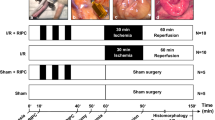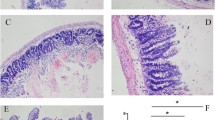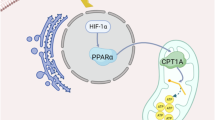Abstract
Gastric mucosa subjected to repeated brief episodes of ischemia exhibits an increased resistance to damage caused by a subsequent prolonged ischemic insult and this is called gastric preconditioning. In this study, L-NNA, a non-selective NO-synthase inhibitor, and aminoguanidine, a relative inhibitor of inducible NO-synthase (iNOS), were applied prior to short ischemia (occlusion of celiac artery 1-5 times for 5 min) followed by a subsequent exposure to 0.5 h of ischemia and 3 h of reperfusion (I/R). Short ischemia significantly reduced the I/R-induced lesions while raising significantly the GBF and luminal NO content. These effects were attenuated by L-NNA and aminoguanidine and restored by addition of L-arginine and SNAP to L-NNA and aminoguanidine. The cNOS mRNA, but not iNOSmRNA, was detected in intact mucosa and only cNOS mRNA was strongly upregulated in the preconditioned mucosa. We conclude that overexpression of cNOS with the subsequent release of NO plays a key role in the mechanism of gastric preconditioning.
Similar content being viewed by others
REFERENCES
Bouchard, J. F. and Lamontagne, D. (1996). Mechanism of protection afforded by preconditioning to endothelial function against ischemic injury, Am. J. Physiol. 271, 1801.
Brzozowski, T., Konturek, S. J., Sliwowski, Z., et al. (1996). Role of capsaicin-sensitive sensory nerves in gastroprotectionagainst acid-independent and acid-dependent ulcerogens, Digestion 57, 424.
Brzozowski, T., Konturek, S. J., Sliwowski, Z., et al. (1997a). Role of L-arginine, a substrate for nitric oxide-synthasein gastroprotectionand ulcer healing, J. Gastroenterol. 32, 442.
Brzozowski, T., Konturek, P. C., Sliwowski, Z., et al. (1997b). Lipopolisaccharide of Helicobacter pylori protects gastric mucosa via generation of nitric oxide, J. Physiol. Pharmacol. 48, 699.
Brzozowski, T., Konturek, P. C., Konturek, S. J., et al. (1999). Role of prostaglandins generated by cyclooxygenase-1 and cyclooxygenase-2 in healing of ischemia-reperfusion induced gastric lesions, Eur. J. Pharmacol. 385, 47.
Brzozowski, T., Konturek, P. C., Konturek, S. J., et al. (2000). Central leptin and cholecystokinin in gastroprotectionagainst ethanol-induced damage, Digestion 62, 126.
Cho, C. H., Ko, I. K. and Tang, X. L. (1994). The differential mechanism of mild irritants on adaptive cytoprotection, Eur. J. Gastroenterol. Hepatol. 9 (Suppl. 1), 24.
Chomczynski, P. and Sacchi, N. (1987). Single step method of RNA isolation by acid guanidinum thiocyanate-phenol-chloroform extraction, Anal. Biochem. 162, 156.
Davenpeck, K. L., Gauthier, T. W. and Lefer, A. M. (1994). Inhibition of endothelial-derived nitric oxide promotes P-selectin expression and actions in the rat microcirculation, Gastroenterology 107, 1050.
Green, L., Trannenbaum S. R. and Goldman, P. (1981). Nitrate synthesis in the germ-free and conventional rat, Science 212, 56.
Hawkey, C. J., Kemp, R. T., Walt, R. P., et al. (1988). Evidence that adaptive cytoprotectionin rats is not mediated by prostaglandins, Gastroenterology 94, 948.
Ishida, T., Yarmizu, K., Gute, D. C., et al. (1997). Mechanism of ischemic preconditioning, Shock 8, 86.
Ko, I. K. and Cho, C. H. (1995). The role of non-protein sulfhydryl compounds in gastric adaptative cytoprotection against ethanol-inducedmucosal damage in rats, Inflamm. Res. 44, 242.
Ko, I. K. and Cho, C. H. (1999). Co-regulation of mucosal nitric oxide and prostaglandin in gastric adaptive cytoprotection, Inflamm. Res. 48, 471.
Konturek, S. J., Piastucki, I., Brzozowski, T., et al. (1981). Role of prostaglandins in the formation of aspirin induced gastric ulcers, Gastroenterology 80, 4.
Konturek, S. J., Brzozowski, T., Piastucki, I., et al. (1982). Role of locally generated prostaglandin in adaptive gastric cytoprotection, Dig. Dis. Sci. 27, 967.
Konturek, S. J., Brzozowski, T., Majka, J., et al. (1992). Transforming growth factor and epidermal growth factor in protection and healing of gastric mucosal injury, Scand. J. Gastroenterol. 27, 649.
Konturek, P. C., Brzozowski, T., Konturek, S. J., et al. (1998). Bacterial lipopolysaccharide protects gastric mucosa against acute injury in rats by activation of genes for cyclooxygenase and endogenous prostaglandins, Digestion 59, 284.
Konturek, S. J., Brzozowski, T., Pajdo, R., et al. (2001). Gastric preconditioning induced by short ischemia: the role of prostaglandins, nitric oxide and adenosine, Med. Sci. Monitor 7, 610–621.
Lowson, C. S. and Downey, I. M. (1993). Preconditioning: state of the art. Myocardial protection, Cardiovasc. Res. 5, 933.
Mercer, D. W., Ritchie, W. P. and Dempsey, D. T. (1992). Do sensory nervous mediate adaptative cytoprotectionof gastric mucosa against bile acid injury?, Am. J. Surg. 163, 12.
Mounsey, R. A., Pang, C. Y., Boyd, J. B., et al. (1992). Argumentation of skeletal muscle survival in the latissimus dorsi parcine model using acute ischemic preconditioning, Otolaryngology 27, 991.
Murry, C. E., Jenning, R. B. and Reimer, K. A. (1986). Preconditioning with ischemia: a delay in lethal cell injury in ischemic myocardium, Circulation 74, 1124.
Nilsson, B., Friman, S., Gustafsson, B. I., et al. (2000). Preconditioning protects against ischemia/ reperfusion injury of the liver, J. Gastrointest. Surg. 4, 44.
Pajdo, R., Brzozowski, T., Konturek, P. C., et al. (2001). Ischemic preconditioning, the most effective gastroprotective intervention: involvement of prostaglandins, nitric oxide, adenosine and sensory nerves, Eur. J. Pharmacol. 427, 263–276.
Parratt, J. R. (1994). Protection of the heart by ischemic preconditioning: mechanismand possibilities for pharmacological exploitation, Trends Pharmacol. Sci. 15, 19–24.
Pawlik, M., Ptak, A., Pajdo, R., et al. (2001). Sensory nerves and calcitonine gene related peptide in the effect of ischemic preconditioning on acute and chronic gastric lesions induced by ischemia-reperfusion, J. Physiol. Pharmacol. 52, 569–581.
Peralta, C., Closa, D., Xaus, C., et al. (1998). Hepatic preconditioning in rats is defined by a balance of adenosine and xanthine, Hepatology 28, 768.
Peralta, E. and Rossello, I. (2000). Hepatic preconditioning preserves energy metabolism during sustained ischemia, Am. J. Physiol. 279, 163.
Przyklenk, K., Zhoo, L., Kloner, R. A., et al. (1996). Cardioprotectionwith ischemic preconditioning and MLA: role of adenosine regulating enzymes?, Am. J. Physiol. 271, 1004.
Rainsford, K. D. (2001). The ever-emerging anti-inflammatories. Have there been real advances?, J. Physiol. (Paris) 95, 11–29.
Robert, A., Nezamis, I. E., Lancaster, C., et al. (1983). Mild irritant prevent gastric necrosis through adaptive cytoprotection mediated by prostaglandins, Am. J. Physiol. 245, 113.
Russell, J., Eppihimer, M. and Gronger, D. N. (1996). Kinetics and modulation of P-selectin expression in mouse intestine exposed to ischemia-reperfusion(I / R), FASEB J. 10 (Suppl.), A612.
Stefano, G. B., Neenan, K., Cadet, P., et al. (2001). Ischemic preconditioning: an opiate constitutive nitric oxide molecular hypothesis, Med. Sci. Monitor. 7, 1357–1375.
Takeuchi, K., Kagawa, S., Mimaki, H., et al. (2002). COX and NOS isoforms involvedin acid-induced duodenal bicarbonate secretion in rats, Dig. Dis. Sci. 47, 2116–2124.
Takeuchi, K., Ueshima, K., Ohuchi, T., et al. (1994). The role of capsaicin-sensitivesensory neurons in healing of HCl-induced gastric mucosal lesions in rats, Gastroenterology 106, 1524.
Wada, K., Kamisaki, Y., Kitano, M., et al. (1996). A new gastric ulcer model induced by ischemia-reperfusion in the rat: role of leukocytes on ulceration in rat stomach, Life Sci. 59, 295.
Whittle, B. J. R. (1994). Nitric oxide in gastrointestinal physiology and pathology, in: Physiology of the Gastrointestinal Tract, 3rd edn, L. R. Johnson (Ed.), p. 267. Raven Press, New York, NY.
Whittle, B. J. R., Lopez-Belmonte, J. and Moncada, S. (1990). Regulation of gastric mucosal integrity by endogenous nitric oxide: interactions with prostanoids and sensory neuropeptides in the rat, Br. J. Pharmacol. 99, 607.
Xuan, Y. T., Tang, X. L., Qiu, Y., et al. (2000). Biphasic response of cardiac NO synthase isoforms to ischemic preconditioning in conscious rabbits, Am. J. Physiol. H2760–H2771.
Rights and permissions
About this article
Cite this article
Brzozowski, T., Konturek, P.C., Pajdo, R. et al. Involvement of nitric oxide (NO) in the mechanism of gastric preconditioning induced by short ischemia. Inflammopharmacology 10, 449–460 (2002). https://doi.org/10.1163/156856002321544918
Issue Date:
DOI: https://doi.org/10.1163/156856002321544918




